In this article
San Luis Obispo, CA, a gem on California’s Central Coast, beckons climbers with its unique mix of readily accessible outdoor crags and superb indoor training spots. Many climbers find it challenging to gather consolidated information for new destinations; this guide aims to fix that for SLO. We’re about to explore everything you need for an incredible rock climbing San Luis Obispo experience in [2025], from its distinctive volcanic rock and varied climbing styles to the welcoming local community. Get ready to discover your next vertical adventure and the best of San Luis Obispo climbing.
Premier Outdoor Climbing Destinations in SLO
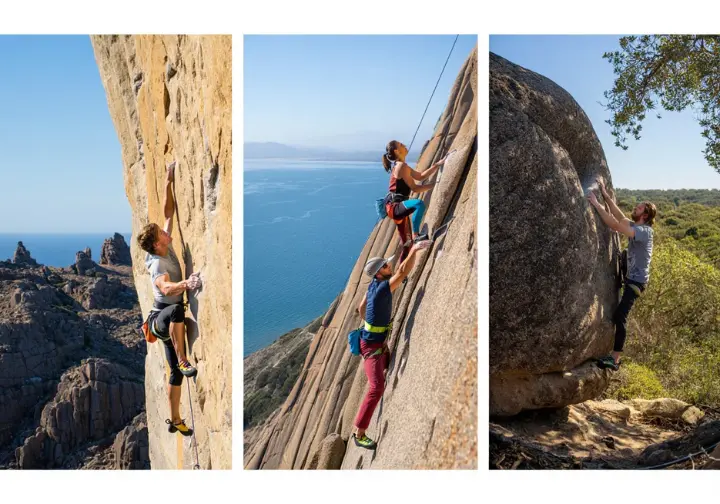
San Luis Obispo and its surroundings offer some fantastic outdoor rock climbing. We’ll explore the top spots, detailing what makes each unique – the type of rock, the styles of climbing available, and the general vibe. Our focus will be on the most popular and well-documented crags, perfect for planning your San Luis Obispo climbing areas exploration. Let’s gear up and look at where you can get your hands on some actual rocks in this prime climbing area.
Bishop Peak: The Crown Jewel of SLO Climbing
Bishop Peak is undeniably the most iconic outdoor climbing spot in San Luis Obispo County, famous for its unique volcanic dacite rock and the unmistakable “P” on its slope. Towering at 1,559 feet, its climbing history is rich, predating even current city stewardship, marking it as a key landmark for local climbers and visiting climbers alike. The peak’s widespread appeal comes from its extensive route selection and diverse climbing opportunities on these prominent rock formations. This mountain is a true highlight for any climbing trip to the Obispo area.
Accessing Bishop Peak is possible via several trailheads, chiefly from Highland Drive, Patricia Drive, and Foothill Boulevard. It’s particularly important to observe parking etiquette in the residential zones near the Highland Drive and Patricia Drive trailheads. Parking is scarce and respecting local residents is paramount for continued access. Knowing these access points and parking rules is key for a hassle-free day of rock climb adventure.
The climbing at Bishop Peak is primarily on dacite, a volcanic rock known for its generally solid nature, providing good friction and engaging features. This rock type shapes the unique climbing experience, influencing hold types and movement. Climbers will find a variety of textures across the different sectors and rock formations. For more details on Bishop Peak’s iconic climbing routes, Mountain Project is an excellent resource.
Bishop Peak offers a wide array of climbing disciplines, including Bishop Peak bouldering SLO (bouldering on its many boulders), sport climbing, and for those interested in understanding traditional (trad) climbing (a form of traditional rock climbing), plenty of trad routes, plus options for top-roping. This variety ensures climbers of all tastes and abilities can find rewarding challenges. The area’s extensive nature readily supports this diversity of styles.
The peak features numerous distinct sub-areas, each with its own atmosphere and popular climbs. Key zones include P-Wall (home to classics like “P-Crack” 5.9- Trad and “Epidural” 5.10a Trad/Sport), Cracked Wall (with “Camel” 5.10b/c Sport), and Shadow Rock (featuring “Shadow” 5.8 Sport/TR). Bouldering sectors like Chlorissa Boulders, sometimes referred to by local climbers with nicknames like the ‘aka orange rocks‘ due to lichen or rock hue in certain light, offer problems such as “Mushy” V3. Roped climbs generally range from 5.8 to 5.11d+, with bouldering from V3 to V8 and beyond. For official management details, refer to the Bishop Peak Natural Reserve Conservation Plan.
Cerro Cabrillo (Cabrillo Peak): Beginner-Friendly Views
Cerro Cabrillo, also known as Cabrillo Peak, is located within Morro Bay State Park and is widely recognized as a superb spot for beginner climbing San Luis Obispo. It’s also great for enjoyable top-roping and sport climbing, all accompanied by rewarding scenic vistas from this mountain. As one of the “Nine Sisters” volcanic plugs, this cerro rises 911 feet, presenting a unique geological setting. Its accessibility and range of easier climbing routes make it a favored choice for many climbers.
To reach Cerro Cabrillo, climbers usually take the South Bay Boulevard exit from Highway 1, north of San Luis Obispo, turn left, and use the designated parking lot for the Cabrillo Trail access. The rock here is rhyodacite, another volcanic formation, which some find a bit slippery, adding a subtle challenge to leads and demanding precise footwork. Always check current Morro Bay State Park regulations before your visit to this Cabrillo landmark.
This climbing area is primarily celebrated for its wealth of top-roping and sport climbing routes, though some traditional rock climbing options also exist. Prominent sub-areas include Rock Land, El Dorado, Old Stone Face, and Park Ridge Rock, each offering a variety of climbs. This focus makes it particularly well-suited for those learning to lead sport routes or preferring the security that is ideal for top-roping. It’s said that across all its sectors, there are more than 120 climbing routes available on Cabrillo Peak.
Cerro Cabrillo provides a good selection of routes with moderate grades. Classic climbs range from 5.6 to 5.12a, with popular options like “Corner Route” (5.6 Sport/TR) and “Black Gold” (5.8 Sport). This grade spread makes it an excellent location for climbers transitioning from gyms to outdoor rock or for those looking to gain experience on easier terrain. You can find more information on Cabrillo Peak sport climbing routes online using resources like Mountain Project.
Irish Hills & Stenner Canyon: Exploring Further Afield
The Irish Hills Natural Reserve, a 720-acre expanse accessed near Prefumo Canyon Road, is more widely known for its extensive network of hiking and mountain biking trails through a rugged, serpentine landscape. While it’s mentioned as having climbing potential, detailed beta on established climbing routes, specific sectors, or grades is less common compared to Bishop Peak. Climbers venturing here should be ready for a more exploratory outing. For an idea of the area, look into Irish Hills Natural Reserve trails. Some local climbers consider this a more adventurous climbing area within San Luis Obispo.
Stenner Canyon Boulders, near Cal Poly with access via Stenner Creek Road, is recognized as primarily a bouldering destination and a notable bouldering area. Parking is often available at the Cal Poly poultry unit or further along Stenner Creek Road. Similar to Irish Hills, comprehensive route information for Stenner Canyon can be sparse in major guides, suggesting it appeals to those seeking less crowded bouldering. Some Stenner Creek Trail information can provide context for the area.
For both Irish Hills and Stenner Canyon, rock type and quality can differ. Irish Hills features serpentine rock, which can be inconsistent for climbing. Stenner Canyon’s geology is likely dacite, similar to nearby Bishop Peak but requires on-site assessment. Climbers should be cautious, thoroughly check rock stability, and be prepared for access nuances or a lack of established information. These less-developed rock formations require extra care.
These locations offer chances for climbers looking to explore beyond the main crags. Given the limited information, consulting hyper-local sources or experienced SLO climbers is wise before a visit. Responsible exploration, Leave No Trace principles, and awareness of being in less-trafficked natural areas are very important. This is different from sports like canyoneering or mountaineering, which have their own specific considerations, though the spirit of adventure might be similar. The scenic Los Padres National Forest borders parts of the region, offering further wilderness experiences for the adventurous climber.
Important Notes on Other SLO Areas (Closures & Limited Info)
It is absolutely vital for climbers to be aware that Cerro Romualdo has been ENTIRELY CLOSED to climbing since January 2006. This climbing area is on land leased by the National Guard (Camp San Luis). Despite past efforts by local climbers to regain access, the closure on Cerro Romualdo remains. Respecting this closure is mandatory for all.
Likewise, climbing on Morro Rock, the iconic landmark in Morro Bay, is STRICTLY PROHIBITED by California State Parks. While visually impressive with its prominent rock formations, Morro Rock is not a permissible climbing area, and attempting to climb it can lead to penalties and harm climber-land manager relations. Adherence to this ban on climbing Morro Rock is necessary.
El Chorro Regional Park, managed by SLO County Parks, is noted as having a “climbing rock.” However, detailed information about this feature—whether it’s a natural outcrop or artificial, its size, the type of climbing it offers, and suitability for various skill levels—is often scarce. Climbers interested might need local beta or to visit and assess it themselves. You can find information on El Chorro Regional Park amenities on the county website. For a general San Luis Obispo climbing overview, Mountain Project is a good starting point.
Top Indoor Climbing Gyms in SLO
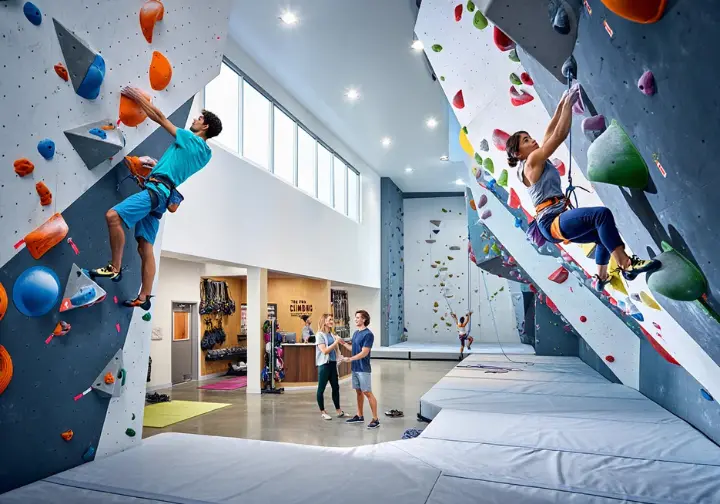
When the weather isn’t cooperating or you’re looking to train on climbing walls, San Luis Obispo’s indoor climbing facilities offer excellent alternatives. This section highlights the primary indoor rock climbing gym, focusing on The Pad Climbing, its history, what it offers, and its role as a central hub for the local climbing community. We’ll look into San Luis Obispo’s Premier Indoor Climbing Gym: The Pad, a key climbing gym in San Luis Obispo, CA.
The Pad Climbing: SLO’s Hub for Climbers
The Pad Climbing boasts a rich history, originating from SLO-Op Climbing, founded in 2003 by Yishai Horowitz as a community-centric bouldering cooperative. By 2017, SLO-Op rebranded and expanded into a significantly larger warehouse, becoming The Pad under CEO Kristin Horowitz. This change allowed for roped climbing and more amenities, establishing it as SLO’s top indoor rock climbing gym.
Located at 888 Ricardo Court, San Luis Obispo, The Pad typically operates from 11 am to 10 pm daily. A major benefit for members is 24/7 access to most areas; roped climbing zones are usually restricted outside staffed hours for safety. This flexible access accommodates various schedules for climbers. You can explore The Pad Climbing San Luis Obispo facilities on their website.
The facility is extensive, featuring about 9,000 sq ft of roped climbing terrain with climbing walls reaching 25-35 feet in height, and around 4,000 sq ft of bouldering terrain with walls 16-18 feet high, all built by Walltopia in 2017. It includes 7 auto-belay stations, a Tension Board, spray wall, campus board, yoga room, weights/cardio gear, a kids’ bouldering area, retail climbing shop, showers, and an outdoor slackline.
The Pad offers various membership options and day passes. As of late 2024/early 2025, standard monthly memberships were around $92, with discounts for youth and students. Adult peak use day passes were about $24. Prices can change, so checking The Pad Climbing membership options for current rates is wise for climbers in Obispo.
Beyond open climbing, The Pad provides instruction, yoga (often donation-based), acro yoga, and youth programs, including teams and a toddler “Nurture Program.” Gear rentals are readily available, with shoes often included with entry. Options include chalk bags, harnesses, belay devices, lead ropes, and even crash pads for outdoor bouldering.
Cal Poly’s Climbing Park: University Resources
Cal Poly San Luis Obispo makes a significant contribution to the local climbing scene with its ASI Poly Escapes Climbing Park, found at the university’s Recreation Center. This facility includes a notable 42-foot climbing tower and a dedicated bouldering area, offering excellent resources for students and the wider community. It’s a great place to hone climbing skills.
The climbing park is generally free for Cal Poly students and Recreation Center members. Visitors and guests can often get guest passes, making it an accessible option for those wanting to try climbing or train. It’s a valuable asset for encouraging new climbers and supporting experienced ones. For more information, see the Cal Poly climbing park details.
ASI Poly Escapes offers various programs, including introductory climbing hours designed to help newcomers feel at ease and learn basic techniques. They also provide belay classes for a small fee (around $15 per research), which are fundamental for anyone wanting to safely manage ropes for climbing partners. These are great first steps to rock climb safely.
The presence of Cal Poly, with its climbing facilities and programs like Poly Escapes outdoor programs, cultivates a strong student climbing community. This student body actively participates in and adds to the vibrancy of the local scene, both at the university’s park and at nearby outdoor crags and commercial climbing gyms.
Essential SLO Climbing Logistics: Access, Gear, and Regulations
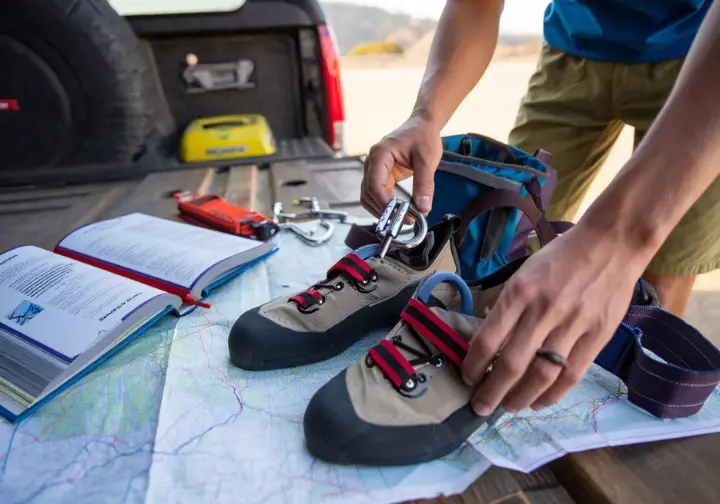
Successfully planning your rock climbing trip to San Luis Obispo for [2025] involves more than just knowing where the rocks are. This section addresses the practical aspects: finding local guidebooks and online beta, sourcing gear, and understanding crucial local rules and access notes for any climbing area. These details will help ensure your climbing days in San Luis Obispo, CA, are smooth and enjoyable.
Guidebooks and Online Beta for SLO
The main printed guidebook for the San Luis Obispo climbing scene has historically been “California Central Coast Climbs: San Luis Obispo” by Tom Slater, published in 2005. This guide has been a key resource, covering spots like Bishop Peak and Cerro Cabrillo with maps and photos. However, given its 2005 publication, climbers in [2025] should note that some access or route details for their climb might be outdated. You might find Tom Slater’s climbing guidebook through resellers.
For the most current information, online resources are vital. Mountain Project San Luis Obispo (mountainproject.com) is indispensable, offering up-to-date details on crags, climbing routes, grades, user-submitted condition reports, and community discussions for areas like Bishop Peak. Other platforms like TheCrag.com and KAYA also serve as valuable digital databases for climbing information. It’s wise to combine resources like print guides with digital tools for a complete picture of the climbing area.
When using any guidebook or online source, especially older ones, cross-referencing information and seeking the latest beta is important. Conditions at crags change due to weather, erosion, or new route development on the rock formations, and access policies can be updated. Always prioritize the most recent information, like current climbing conditions and routes, before heading out to climb.
Local Gear Shops and Rentals
Mountain Air Sports, at 667 Marsh St, San Luis Obispo, is a long-established (since 1975) local outdoor retail store and a key spot for climbers. They stock climbing gear, including ropes, shoes, harnesses, and protection, making it convenient for purchasing necessary equipment. They are also a likely place to find any available local or regional climbing guidebooks at this climbing shop.
While Mountain Air Sports offers various rentals for outdoor activities, climbers should inquire directly about specific climbing gear rentals for outdoor use, like shoes or harnesses, if not bringing their own. Some gear, like ropes and protection for traditional rock climbing, is less commonly rented by shops due to liability.
For indoor rock climbing, The Pad Climbing gym offers comprehensive gear rental services. This usually includes shoes (often free with entry), harnesses, belay devices, and chalk bags. They also uniquely offer crash pad rentals for bouldering for members (free) and guests (for a fee), a great service for trying outdoor bouldering at Bishop Peak or Stenner Canyon boulders without immediately buying a pad.
Understanding SLO Climbing Regulations & Access
Climbing in City of San Luis Obispo Open Spaces, such as Bishop Peak and Irish Hills, is covered by Chapter 12.22 of the Municipal Code. Key City of San Luis Obispo Open Space rules include climbing only in “specific designated areas,” potential liability waiver needs, and a ban on installing new climbing bolts without written approval from the Parks and Recreation Director. An advisory committee of climbers may also provide input. You can review the official City Open Space ordinance for full details on these rock climbing regulations.
General access hours for City Open Spaces are dawn to dusk; being present between one hour after sunset and one hour before sunrise is typically not allowed without approval. This is important for planning. Note that some areas like Cerro San Luis Natural Reserve may have specific winter evening access permit programs. This section on Understanding SLO Climbing Regulations is vital.
For areas within Morro Bay State Park, such as Cerro Cabrillo (or Cabrillo Peak), climbers must follow California State Park regulations. This includes respecting all posted rules on resource protection, trail use, and bans like the one on climbing Morro Rock. Standard Leave No Trace principles are also expected.
It’s absolutely necessary for climbers in [2025] to always check current access status, parking rules, and any temporary closures for all climbing areas before visiting. Information changes, and checking official City and State Park websites or contacting ranger services is best for compliance for any rock climb.
Safety First: Navigating Hazards and Climbing Responsibly in SLO
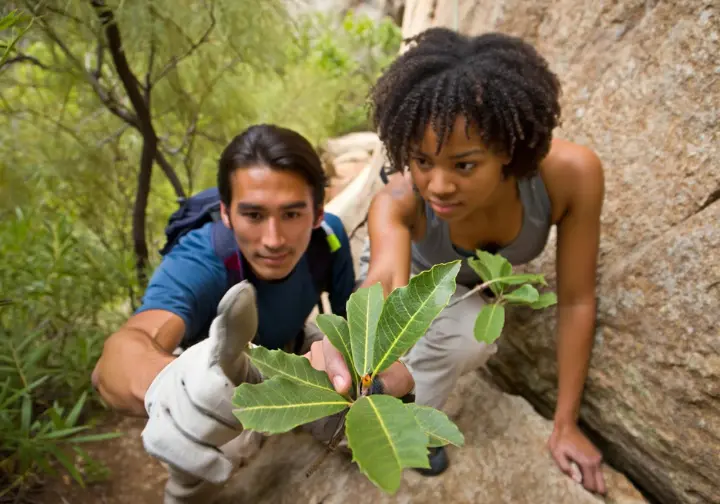
This part of our guide focuses on safe rock climbing practices in San Luis Obispo. We’ll cover identifying and managing the notorious poison oak, understanding other local hazards, and promoting responsible climbing ethics. Adhering to Leave No Trace principles is key to preserving these beautiful climbing areas for everyone to enjoy now and in the future, whether bouldering or rope climbing.
The Poison Oak Menace: Identification and Prevention
Poison oak is a significant and highly common hazard in the San Luis Obispo area, often found along trails and at climb bases, especially at Bishop Peak. The irritant, urushiol oil, can bind to skin within 15 minutes, making avoidance and quick action vital for climbers. Exposure can lead to intensely itchy rashes. As hikers beware the poison oak, climbers must be even more vigilant.
Learning to identify poison oak is your first defense. It typically has three-leaf clusters, but appearance varies (shiny, dull, reddish leaves; vine or shrub). Familiarize yourself with its forms. For help, resources on recognizing poison ivy oak and sumac can be useful for any rock climbing enthusiast exploring vegetated areas.
Prevention includes wearing long sleeves and pants, especially when approaching climbs or in brushy areas. Stay on established trails and be cautious when placing gear or touching vegetation. Urushiol oil can linger on clothing, ropes, gear, and pets, causing secondary exposure if not cleaned properly after a day of climbing.
If contact is suspected, wash affected skin immediately (ideally within 5-10 minutes) with soap and cool water; dish soap is often recommended. If a rash develops, calamine lotion or hydrocortisone cream can help. For severe reactions, or if widespread or affecting sensitive areas, seek medical attention. Never burn poison oak, a crucial tip for all climbers.
Other Wildlife and Environmental Hazards
Beyond poison oak, climbers in SLO should be aware of other local wildlife. Rattlesnakes are present in California and may be encountered on trails or among rocks, especially in warmer weather; be careful where you place hands and feet, and look out for the occasional lizard too. Ticks are also common in grassy and brushy areas, so do tick checks after climbing. The FDA offers advice on outsmarting poison ivy and other poisonous plants, which is a good mindset for general plant awareness.
Coyotes are sometimes seen; store food securely and avoid leaving scraps. Though rare, mountain lions inhabit many parts of California; be aware, especially if climbing at dawn/dusk or in more remote areas. Always check Bishop Peak trail conditions or similar resources for recent wildlife advisories if available, as these can affect any climb.
Rockfall is an inherent risk. While Bishop Peak’s dacite is generally solid, always wear a helmet, especially when belaying or climbing in areas with potential for loose rock. Less-traveled climbing routes or areas affected by recent rain or freeze-thaw cycles may have higher rockfall risk.
Weather on the Central Coast can vary, with fog, sun, and wind, sometimes in one day. Summers can be hot. Rain can make rock slippery; however, some dacite boulders at Bishop Peak are known to dry relatively quickly. Always check the forecast before any rock climbing outing.
Climbing Ethics and Leave No Trace in SLO
Adhering to strong Climbing Ethics and Leave No Trace principles is essential for protecting SLO’s climbing areas and maintaining access for all climbers. This includes packing out everything you pack in – all trash, food scraps, and even toilet paper. Following local crag etiquette guidelines is also part of this responsible climbing.
Stay on established trails to minimize erosion and avoid damaging vegetation. Do not cut switchbacks. At climb bases, minimize impact by using durable surfaces and avoiding trampling plants. Refrain from using plants as gear racks when engaged in any rock climbing activity.
Minimize visual impact. Brush off excessive chalk and tick marks after your climbing session to leave the rock natural for others. Avoid loud noises and be considerate of other climbers and recreational users who share these public spaces. Respect wildlife by observing from a distance. For broader context on national climbing advocacy and conservation, the Access Fund provides valuable insights.
Specific to SLO, parking etiquette is very important, especially at Bishop Peak trailheads near residential areas (Highland Drive, Patricia Drive). Park legally and considerately, avoid blocking driveways or creating noise, and carpool whenever possible to reduce congestion. Your behavior as climbers in these sensitive access zones directly impacts future climbing access in San Luis Obispo.
Conclusion: Your San Luis Obispo Climbing Journey Starts Now
San Luis Obispo presents a varied and fulfilling rock climbing scene for [2025], featuring iconic outdoor areas like Bishop Peak and Cerro Cabrillo, alongside excellent indoor rock climbing training at The Pad Climbing. This unique combination caters to many preferences for different types of climbs.
Successful and responsible climbing here hinges on careful planning for access, knowing local rules, being acutely aware of hazards such as poison oak, and diligently following Leave No Trace ethics. These practices ensure both safety and preservation of these special places for all climbers.
Make use of resources like Mountain Project for up-to-date conditions and the Tom Slater guidebook for historical context. However, always prioritize safety and double-check information before you head out to any San Luis Obispo climbing areas or specific climbing routes.
Whether you are a seasoned climber or new to the sport, SLO’s distinctive volcanic rock and varied climbing styles, from bouldering to sport climbs, and supportive community offer abundant chances for adventure and skill growth. What part of SLO climbing are you most excited to explore?
Embrace the spirit of discovery, respect the natural environment and local communities, and enjoy the distinct challenges and beauty that rock climbing San Luis Obispo provides. We hope this guide helps you prepare for an outstanding climbing trip to Luis Obispo.
Frequently Asked Questions about Rock Climbing San Luis Obispo
What are the best beginner-friendly outdoor climbing spots in San Luis Obispo? >
How bad is the poison oak in SLO climbing areas, and how can I avoid it? >
Do I need a permit to climb at Bishop Peak or other SLO crags? >
Is there much bouldering in San Luis Obispo? >
We are a participant in the Amazon Services LLC Associates Program, an affiliate advertising program designed to provide a means for sites to earn advertising fees by advertising and linking to Amazon.com. As an Amazon Associate I earn from qualifying purchases. We also participate in other affiliate programs. The information provided on this website is provided for entertainment purposes only. We make no representations or warranties of any kind, expressed or implied, about the completeness, accuracy, adequacy, legality, usefulness, reliability, suitability, or availability of the information, or about anything else. Any reliance you place on the information is therefore strictly at your own risk. Additional terms are found in the terms of service.



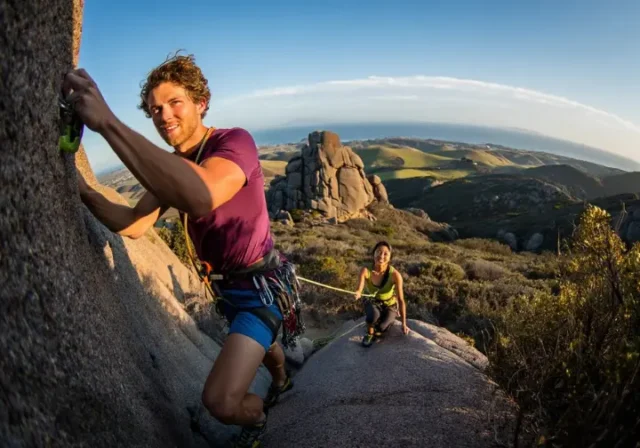


![Joshua Tree Climbing Guide: The Ultimate [2025] Planner The ultimate Joshua Tree climbing guide [2025] planner: climber on a summit overlooking the iconic desert landscape at golden hour.](https://rockclimbingrealms.com/wp-content/uploads/2025/03/01-joshua-tree-climbing-guide-ultimate-2025-planner-238x178.webp)




